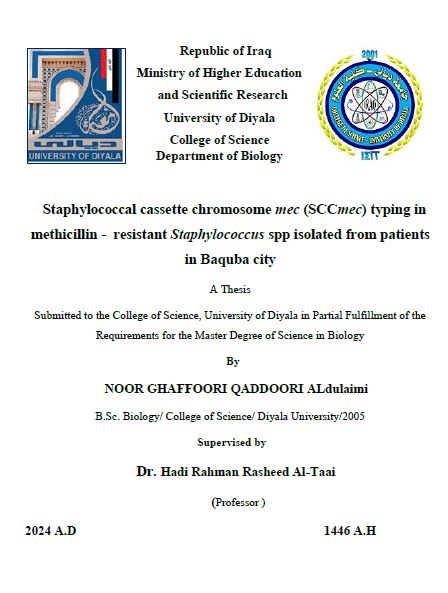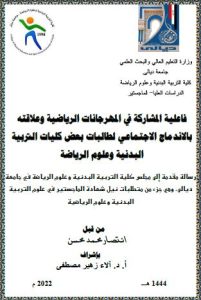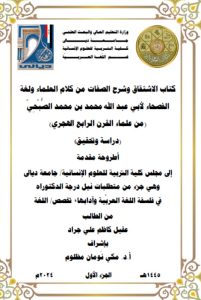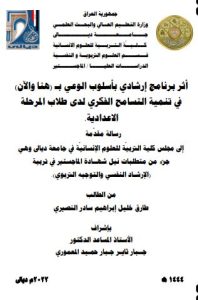المستخلص
Multidrug-resistant Staphylococcus strains have been responsible for an alarming rise in hospital-related infections in recent years. Therefore, Staphylococcal cassette chromosome mec typing has been used as a main tool in the molecular epidemiology of methicillin resistant Staphylococcus aureus (MRSA) to understand the evolution of these Staphylococcus species.
Two hundred twenty-two clinical samples were collected from patients who attended various hospitals in Diyala province between September 2023 and January 2024. These samples included specimens from (burn, wound, ear, nasal, throat swabs, urine, blood, fluid, and abscesses). The study results indicated that bacterial isolates were found in 130 specimens, while 92 specimens tested negative. Utilizing both conventional microbiological methods and the VITEK 2 Compact system, it was determined that 42 out of the isolates, constituting 18.9% of the total, were identified as Staphylococcus aureus isolates. In contrast, 27 isolates, constituting 12.1% of the total, were identified as Staphylococcus epidermidis. Methicillin resistance isolates were identified employing the diffusion method of Cefoxitin discs. The results showed that 28/42 (66.6%) of the S.aureus isolates were methicillin-resistant (MRSA), while 14/42 (33.3%) of them were methicillin-sensitive S.aureus (MSSA). At the same time, the results showed that 17/27 (62.9%) of the S. epidermidis isolates were methicillin-resistant (MRSE), while 10/27 (37.03%) of them were methicillin-sensitive S. epidermidis (MSSE).
The prevalence of S. aureus isolates was highest in Ear swabs, accounting for 8 /28 (28.57%) cases, followed by wounds with 6 / 28 (21.4%), Nasal swabs with 4 / 28 (14.2%), 3 isolates out of 28 (10.7%) for both blood, Throat swab and burn swab and lastly, urine with 1/28 (3.57%). While the prevalence of S. epidermidis isolates was as follows: 8 / 27 (29.6%) isolates from blood, 7 / 27 (25.9%) isolates from burns, 5 / 27 (18.5%) isolates from urine, 4 / 27 (14.8%) isolates from Wounds, 2 / 27 (7.4%) from Ear swabs, and lastly 1 / 27 (3.7%) isolate from Nasal swabs.
All the (42) S. aureus isolates showed positive results for the extracellular enzyme coagulase (CoPS), Dnase, and Gelatinase tests. In contrast, they showed negative oxidase enzyme results, and all S. aureus isolates produced clear β-hemolysis on blood agar around their colonies. At the same time, (27) S. epidermidis isolates showed negative results for the extracellular enzyme coagulase (CoNS), Dnase, Gelatinase tests, and oxidase enzyme and also, S. epidermidis does not produce any hemolysis around their colonies.
The results of antibiotic resistance of all MRSA isolates were determined against (12) types of antibiotics as follows: The resistance rate to Ceftriaxone (96.4%), Amoxilline-clavulanic acid (82.1%), Aminoglycosides group (Gentamycin, Netlimycin, Streptomycin, Kanamycin, Amikacin and Tobramycin) are 42.8%, 3.5%, 42.8%, 67.8%, 7.1% and 21.4%, respectively, Azithromycin (78.5%), Ciprofloxacin (42.8%) and Trimethoprim-sulfamethoxazole (32.1%), Tetracyclin (60.7%). In contrast, the results of antibiotic resistance of all S. epidermidis isolates were determined against (12) types of antibiotics as follows: The resistance rate to Ceftriaxone (96.2%), Amoxilline-clavulanic acid (29.6%), Aminoglycosides group (Gentamycin, Netlimycin, Streptomycin, Kanamycin, Amikacin and Tobramycin) are 14.4%, 3.7%, 3.7%, 48.1%, 3.7% and 14.8%, respectively, Azithromycin (74%), Ciprofloxacin (33.3%) and Trimethoprim-sulfamethoxazole (70.3%), Tetracyclin (51.8%).
The twenty-eight MRSA isolates could be categorized into two distinct patterns based on antibiotic resistance profiles. Specifically, 13 / 28 (46.4%) isolates were classified as multidrug-resistant (MDR) isolates, while 15 / 28 (53.5%) were categorized as extensively drug-resistant (XDR) isolates. In comparison, the twenty-seven S. epidermidis isolates showed that 5 (18.5%), 10 (37.03 %), and 12 (44.4%) of the isolates were MDS, MDR, and XDR, respectively.
Detection of phenotyping for biofilm using the Micro-titer plate in MRSA shows 15/28 (53.5%) of isolates were strong biofilm-forming, and 11/28 (39.2) were moderate, while 2/28 (7.1%) were weak biofilm-forming. In contrast, the current findings reveal that 18 / 27 (66.6%) S.epidermidis isolates were classified as weak biofilm formation, while 9 / 27 (33.3%) were categorized as moderate biofilm formation. The relationship between biofilm formation and antibiotic resistance: the current study showed a negative relationship between biofilm formation and S. epidermidis, as most of the resistance to antibiotics was in weak biofilm formation. At the same time, these results are not consistent with the results of S. aureus, where most of the antibiotic resistance was in the strong biofilm formation positive correlation.
In the current study, (10) MRSA Gentamycin resistant isolates were subjected to polymerase chain reaction technique to amplify the mecA gene, and they recorded positive results reaching to 100%. At the same time, (5) MRSE Gentamycin-resistant isolates were recorded positive results, reaching 80%. In contrast, the result of the current study revealed that the percentage of the PVL gene among 15 isolates tested for both strains of Staphylococci was 0 (0%). This indicates that all isolates were Hospital acquired.
Aminoglycoside resistance genes were screened for in isolates using PCR amplification. The PCR analysis revealed that out of 10 MRSA isolates, 2 (20%) harboured aac(6′)-le-aph(2”), 2 (20%) harboured aph(3’)-IIIa, while ant(4’)-Ia gene was utterly absent. While for S. epidermidis, multiplex-PCR results showed that the frequency of aac(6’)-Ie-aph(2”), aph(3’)-IIIa, and ant(4’)–Ia genes among 5 MRSE isolates were 20%, 20%, and 20%, respectively.
Depending on the detection of the SCCmec type among meticillin-resistant Staphylococci for the investigation of SCCmec classes, a PCR assay showed that most MRSA isolates 7/10 (70%) were type I, followed by 1/10 isolate (10%) was type III, which confirms the extremely high dissemination of SCCmec class 1 at the hospitals of Baqubah in Diyala province. In contrast, SCCmec types II, IV and V were utterly absent. At the same time, only one SCCmec class was identified for MRSE. Most isolates 3/5 (60%) were type I, followed by 2/5 (40%) were non-typeable. We couldn’t identify MRSE isolates of the SCCmec types II, III, IV, and V.
The results of typing 10 isolates of extensively drug-resistant MRSA indicated the presence of 7 distinct clones, further categorized into two main clusters and two subgroups, and three isolates were found to be unique and separate based on the established cutoff value. At the same time, for 5 isolates of extensively drug-resistant MRSE, the results indicated the presence of 4 distinct clones and one isolate was unique. It is considered the parent isolate for other cloned isolates.





